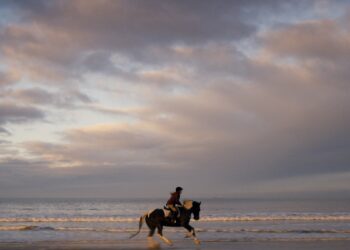Eimear Lawlor shares her favourite places to visit in the charming Kilkenny town and talks about switching lanes at 40
Where to eat: Lime Tree, Castlecomer Square
I’ve been to the Lime Tree Restaurant on numerous occasions, and to say it’s amazing is an understatement. Don’t be fooled by its small size; it packs a big punch in every aspect. From the moment you walk in, you’re greeted with a warm and inviting atmosphere. The owners, Evan and Anna, are incredibly nice and make you feel right at home. The staff are efficient and very friendly.
The food is always fresh, plentiful, and wholesome, offering excellent value for money. They cater to all dietary preferences, including vegan and vegetarian options. Their curry, in particular, is extremely tasty and a must-try, and also great coffee and desserts, which are divine and hard to resist.
Two of my favourite dishes are chicken and mushroom vol au vents served with chips and a lovely mixture of salads, my husband’s roast beef went down very well too. Great coffee, friendly service.
Where to drink: Lark’s Bar, Avalon Hotel
The Avalon House Hotel in Castlecomer, Co. Kilkenny is a restored 19th-century house in the heart of the town of Castlcomer, and a short walk from the Castlecomer Discovery Park.
The hotel was given a face lift during Covid and parts are modernised but in keeping with the old world feel. Lark’s Bar in the hotel is a favourite place of mine. I often find hotel bars can be cold and generic, but The Avalon has created a cosy atmosphere, and in winter it is enhanced by a charming wood-burning stove, makes it the perfect spot to unwind.
The bar offers a diverse selection of drinks, including local and international wines, beers, and spirits, and great coffee. The staff are always friendly and attentive.
Where to get fresh air: Castlecomer Discovery Park
One of my favourite places to walk is Castlecomer Discovery Park. The park has transformed over the years from a small circular walk to spreading out over 80 acres of beautiful woodlands and lakes. It’s a perfect spot for nature lovers, with its lovely landscapes and peaceful lakes.
The park is a must for anyone who loves the outdoors, whether you’re on your own or with the family. There’s lots to do!
As you walk around the park you can see the longest zipline in Ireland. I’m not one for heights so hats off to anyone who does it – I can only imagine the amazing views. I prefer the more chilled paddleboat or canoe and enjoy a peaceful ride on the lakes. Archery is great fun too; see if you can hit the target. And if you’re into biking, the park has mountain biking trails for everyone, from beginners to pros.
Where to browse – Market Yard
In The Discovery Park, I enjoy visiting the Market Yard, particularly because I love arts and crafts. The Craft Yard hosts a variety of shops, each offering unique, handcrafted items made by local artisans. Here you can find beautiful handmade jewellery crafted with care, often featuring locally sourced materials, and unique pottery and ceramics, including both functional pieces like mugs and bowls and decorative art. Additionally, the artwork, including paintings, prints, and other creations by local artists, reflects the beauty and culture of the region. It’s a perfect place if you are looking for a memento of your visit or a special present for someone.
Random gem: Heyward Gardens, Ballinlakill, Co Laois
I discovered Heywood Gardens this year, even though I’ve driven through Ballinakill for years without realising they existed. (Ballinakill is a small village on the R432 regional road between Abbeyleix, Ballyragget and Castlecomer). We chose Heywood Gardens for our family walk on my daughter, Ciara’s anniversary, continuing a tradition that started with a large memorial fundraising walk a year after she passed away. Despite the rain, we persevered, and it was a truly special experience.

The gardens have been recently taken over by the OPW (Office of Public Works), and are being carefully restored to their former splendour. This really is an undiscovered gem, with its beautiful landscaped grounds. Originally a large country house, Heywood House, stood overlooking the gardens, but it was demolished in the 1950s due to economic difficulties and the impracticality of maintaining such a large estate in the post-war period.
Writing with MS (Multiple Sclerosis)
My Multiple Sclerosis diagnosis came after the birth of my second child, Ciara. I suffered from extreme fatigue and had a few motor problems. I found that stress exacerbated them, and my husband and I decided I would become a stay-at-home mum. At the time, I had been teaching, but I never felt I lost anything when I made the switch. Instead, I gained the immense joy of being a mother, a role that brought me unparalleled fulfilment.
It wasn’t until my 40th birthday that I started taking writing seriously. Ciara, who was about ten at the time, told me I should do something with my life other than drinking coffee in town with my friends! Her words struck a chord, and I enrolled in a creative writing course. From the moment I penned my first story, I fell in love with the craft. Writing became a passion, a way to express myself and explore new worlds through my imagination.
After the course, I continued writing, and what started as a short story evolved into a novel. I poured my heart and soul into my writing, crafting characters and plots that felt real and vivid. I finished my first draft shortly before Ciara passed away. Her death shattered me. Grief frazzles a person’s brain, making it impossible to think, concentrate, or cope with anything. It is all-consuming, an overwhelming fog that clouds every aspect of life.
Writing through grief
In my struggle to deal with the grief, I sought therapy. My therapist suggested writing down my feelings, so I started a ‘Dear Ciara’ diary. At first, it was a way to channel my pain and madness, a desperate attempt to keep her memory alive. Writing to Ciara became a daily ritual. It helped me process my emotions, and I looked forward to those moments when I could pour out my heart on paper. Over time, I began to include updates about our family. I told Ciara what her two brothers were doing, shared anecdotes about their lives, and described what her dad was up to. Writing became a means to bridge the gap between the past and the present, a way to keep Ciara connected to our lives.
In 2019, while trying to find new ways to cope and move forward, I saw a post on Facebook. An agent, Kate Nash from Oxford was coming to Dublin, looking for Irish writers. I sent her my manuscript, and to my astonishment, she signed me. In February 2020, Kate was going to bring my manuscript to the London Book Fair but Covid happened. In one way, it was to my advantage because Kate ultimately emailed my manuscript out to ten publishers. Eventually, I secured a three-book deal with Head of Zeus.
Writing my second book was a daunting task. It took much longer than I anticipated due to two significant challenges: Covid and the pervasive grief that still lingered. The pandemic added layers of complexity to everything, and grief made even the simplest tasks seem insurmountable. The madness of grief took a new understanding because days I felt like screaming that we hadn’t lost Ciara. Throughout this journey, writing has been my anchor. It has allowed me to navigate the turbulent waters of grief and loss, providing a sense of purpose and a way to honour Ciara’s memory. I feel Ciara was on the journey in the book.

Eimear’s new book
The inspiration for Kitty’s War was something my father-in-law said on his deathbed. He said he had shot at a German because he was trying to steal some food. He had been a reservist on Spike Island during The Emergency in World War II. In my head, I already had the beginnings of a story and the end. I was writing about a young woman who has difficult choices to make while overcoming her past. It is strange, but I know the feeling I want to create in a story; it is an emotional arc. I just have to figure out how to craft a story around it.
Kathleen “Kitty” Flinn’s life unfolds against the backdrop of Ireland’s neutrality and the secret internment of German soldiers at The Curragh Camp in County Kildare. Moving back to Ireland from the bomb-ravaged streets of London in 1941, Kitty navigates love, loss, and survival in the serene yet turbulent Irish countryside. The novel captures her scarred and disillusioned relationship with her brother Anthony, who returns from fighting in the Spanish Civil War. Their lives are further complicated by their encounters with a German airman, Markus, whose presence brings danger to the attention of G2, Irish Military Intelligence, due to her brother’s past.
I would like the reader to go on on an emotional journey. Through Kitty’s eyes, the reader will experience her struggles and see her strength as a woman, the weight of her choices and the resilience she demonstrates throughout the story.
Ultimately, I want to convey a message of hope – that despite the hardships and challenges life throws at us, we go on regardless.








